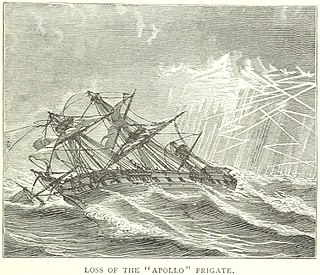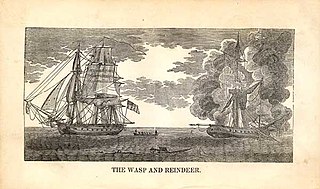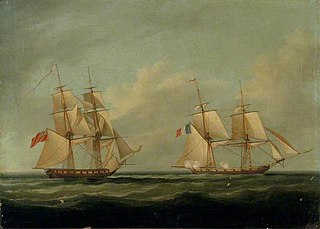HMS Pickle was a topsail schooner of the Royal Navy. She was originally a civilian vessel named Sting, of six guns, that Lord Hugh Seymour purchased to use as a tender on the Jamaica station. Pickle was at the Battle of Trafalgar, and though she was too small to take part in the fighting, Pickle was the first ship to bring the news of Nelson's victory to Great Britain. She also participated in a notable single-ship action when she captured the French privateer Favorite in 1807. Pickle was wrecked in 1808, but without loss of life.

HMS Apollo, the fourth ship of the Royal Navy to be named for the Greek god Apollo, was a fifth-rate frigate of a nominal 36 guns. She was the name ship of the Apollo-class frigates. Apollo was launched in 1799, and wrecked with heavy loss of life in 1804.

HMS Reindeer was a Royal Navy 18-gun Cruizer-class brig-sloop of the Royal Navy, built by Samuel & Daniel Brent at Rotherhithe and was launched in 1804. She was built of fir, which made for more rapid construction at the expense of durability. Reindeer fought in the Napoleonic Wars before succumbing in 1814 to the guns of USS Wasp during the War of 1812.

HMS St Lawrence was a 14-gun schooner of the Royal Navy. She had been built in 1808 in St. Michaels, Talbot County, Maryland for Thomas Tennant and sold to Philadelphians in 1810. During the War of 1812 she was the US privateer Atlas. The UK captured her in 1813 and renamed her St Lawrence. The US privateer Chasseur recaptured her in 1815, and then HMS Acasta re-recaptured her.

HMS Curieux was a French corvette launched in September 1800 at Saint-Malo to a design by François Pestel, and carrying sixteen 6-pounder guns. She was commissioned under Capitaine de frégate Joseph-Marie-Emmanuel Cordier. The British captured her in 1804 in a cutting-out action at Martinique. In her five-year British career Curieux captured several French privateers and engaged in two notable single-ship actions, also against privateers. In the first she captured Dame Ernouf; in the second, she took heavy casualties in an indecisive action with Revanche. In 1809 Curieux hit a rock; all her crew were saved but they had to set fire to her to prevent her recapture.
HMS Pike was a Royal Navy Ballahoo-class schooner of four 12-pounder carronades and a crew of 20. The prime contractor for the vessel was Goodrich & Co., in Bermuda, and she was launched in 1804. She captured one 10-gun enemy vessel before being herself captured, and recaptured.
The Royal Navy used several vessels that were described as His Majesty's hired armed cutter King George. Some of these may have been the same vessel on repeat contract.
There have been twelve ships of the Royal Navy that have been named HMS Flying Fish, after the Flying Fish.
HMS Saint Lucia was a brig-sloop, the former French Navy schooner Enfant Prodigue, which the British captured in 1803 and took into service with the Royal Navy. Under the British flag she captured three small French privateers and several prizes in the Leeward Islands before two French privateers recaptured her in 1807.
HMS Guachapin was a brig, the former Spanish letter of marque Guachapin, launched at Bayonne in 1800, which the British captured early in 1800 and took into service with the Royal Navy. Under the British flag she captured a Spanish privateer larger and better-armed than herself. She also served at the captures of the islands of St. Bartholomew, St. Martin, St. Thomas, St. Croix, Tobago, and St. Lucia, and of Surinam. She served at Antigua as a guard ship but was wrecked in 1811. She was then salvaged and sold.

HMS Superieure was the French privateer Supérieure, which was built in 1801 in Baltimore, Maryland, and which the British captured in 1803 in the West Indies, and took into the Royal Navy. She spent most of her career on the Jamaica and Leeward Islands stations, where she captured numerous privateers. She participated in several notable single-ship actions, including one in which she harassed a frigate, and two campaigns that would, in 1847, earn her surviving crew members the Naval General Service Medal (NGSM). She was laid-up in Britain in 1810 and sold in 1814.
Poisson Volant, was a popular name for French vessels, including naval vessels and privateers. Between 1760 and 1814, warships of the Royal Navy captured numerous privateers named Poisson Volant.
HMS Unique was the French 12-gun schooner Harmonie that Cyane captured from the French in 1804. A French privateer recaptured and sank Unique in 1806.
HMS Netley was launched in 1798 with an experimental design. During the French Revolutionary Wars she spent some years on the Oporto station, where she captured many small privateers. The French captured her in 1806, early in the Napoleonic Wars. They lengthened her and she became the 17-gun privateer Duquesne. In 1807 the British recaptured her and the Royal Navy returned her to service as the 12-gun gun-brig HMS Unique. She was expended in an unsuccessful fire ship attack at Guadeloupe in 1809.
HMS Spencer was a 16-gun brig-sloop of the Royal Navy, formerly the civilian Sir Charles Grey. The Admiralty purchased her in 1795, after having hired her in 1793-94, and renamed her HMS Lilly in 1800. The French privateer Dame Ambert captured her in 1804 and Lilly became the French privateer Général Ernouf. She blew up in 1805 while in an engagement with HMS Renard.
At least seven vessels of the Royal Navy have borne the name HMS Firefly:
HMS Flying Fish was a 6-gun schooner taken into Royal Navy service in 1793. Flying Fish is notable for being the first ship in which William Beatty served as acting-surgeon from 1793 to 1794. Beatty was the naval surgeon who would go on to famously treat Admiral Nelson at the Battle of Trafalgar in 1805.
His Majesty's Hired armed cutter Sandwich served the Royal Navy from 23 May 1798 until the French frigate Créole captured her on 14 June 1799. She then served in the French Navy until the Royal Navy recaptured her on 15 October 1803. The Navy purchased her in 1804 and she served for some months in 1805 as HMS Sandwich before she was sold in Jamaica. During this period she captured three small French privateers in two days.
HMS Tobago was a schooner of unknown origin that the British Royal Navy purchased in 1805. In 1806 a French privateer captured her. The Royal Navy recaptured her in 1809 and took her into service as HMS Vengeur before selling her later that year.
Fowey was launched in 1798. She spent a little more than a year-and-a-half as a hired armed cutter for the British Royal Navy. She was sold in 1800 and became a privateer. Her fate after 1804 is currently obscure.





